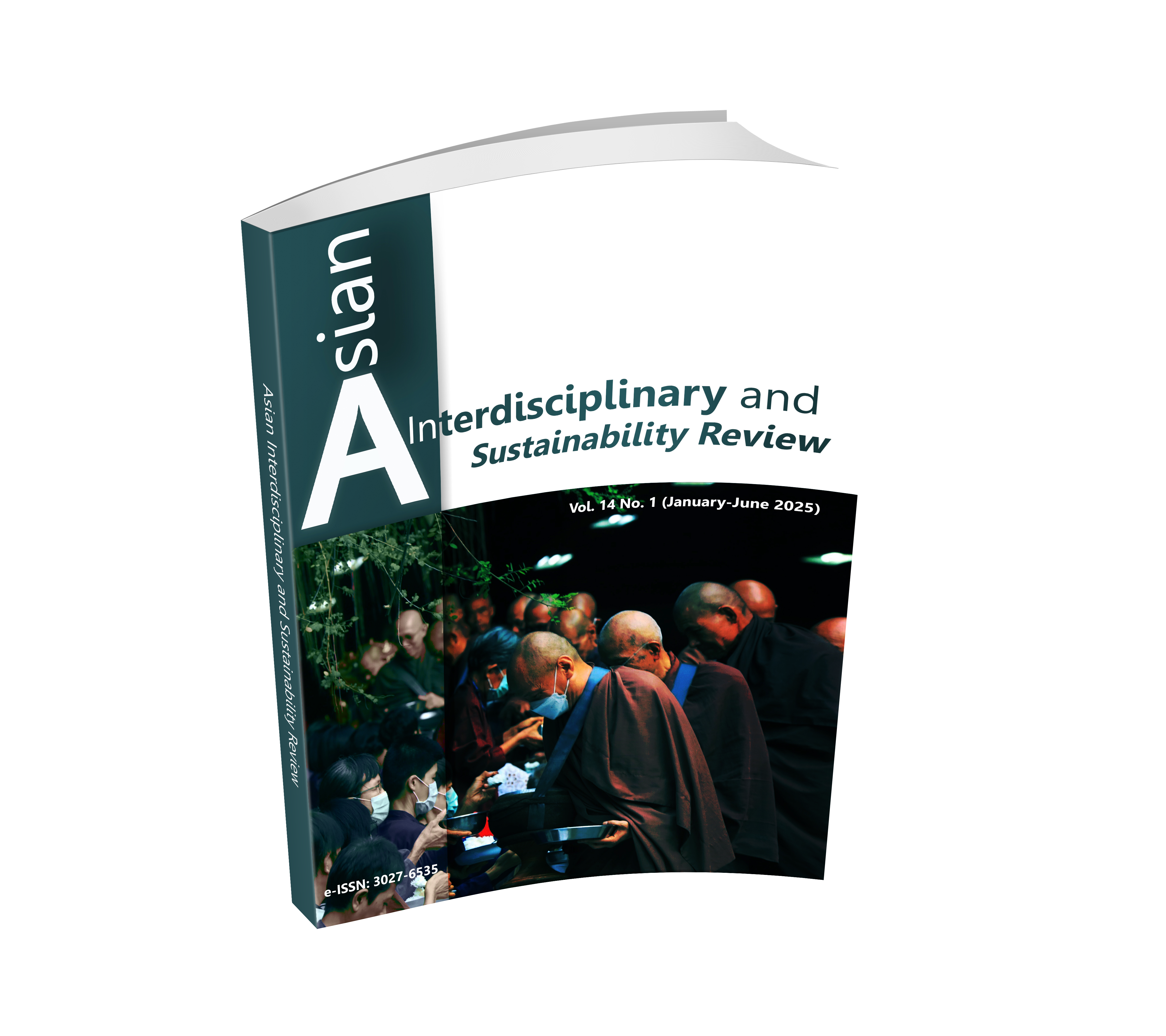DEVELOPMENT AND VALIDATION OF CYBERBULLYING SITUATIONAL SCALE FOR YOUNG ADULTS IN ONLINE ENVIRONMENTS
DOI:
https://doi.org/10.14456/aisr.2025.5Keywords:
Cyberbullying, Cyberbullying Scale, OnlineAbstract
The global rise in digital technology has led to an increase in cyberbullying, particularly among young adults in Thailand. This study aimed to develop a cyberbullying situational scale, focusing on 490 participants aged 18-24 residing in Bangkok and its metropolitan area for over one year. Exploratory Factor Analysis (EFA) and Confirmatory Factor Analysis (CFA) were conducted to validate the scale. The 18-item questionnaire, based on cyberbullying scenarios in Thailand, was evaluated for content validity using the Index of Item-Objective Congruence (IOC), with three experts assessing the questionnaire to ensure its validity. Reliability was assessed using Cronbach's alpha, and correlations were analyzed using the LISREL program and SPSS. The overall Cronbach's alpha coefficient for the scale was .81, and the Corrected Item-Total Correlation (CITC) for all items exceeded .2. The data analysis included frequency, mean, and results from the EFA, along with eigenvalues and factor loadings. The CFA results indicated that the scale fit the empirical data well, demonstrating construct validity. The cyberbullying factors were divided into four situations: 1) Harassment, 2) Outing and Trickery, 3) Denigration, and 4) Impersonation, which aligned with the literature on cyberbullying scenarios in Thailand. The correlation analysis using Pearson’s correlation coefficient revealed that the cyberbullying situational scale had a statistically significant positive correlation with the aggression scale (r = .87) and a statistically significant negative correlation with the empathy scale (r = -.87).
Downloads
References
Alhashmi, A., Kumar, K., Eid, A., Mansouri, W., Othman, S., Miled, A., & Darem, A. (2023). Taxonomy of Cyberbullying: An Exploration of The Digital Menace. Journal of Intelligent Systems and Applied Data Science, 1(2), 1-10.
Balakrishnan, V. (2015). Cyberbullying among young adults in Malaysia: The roles of gender, age and Internet frequency. Computers in Human Behavior, 46, 149-157.
Bartlett, M. (1950). Tests of significance in factor analysis. British Journal of Psychology, 3(2), 77-85.
Cook, S. (2022). Cyberbullying facts and statistics for 2018-2022. Retrieved from www.comparitech.com/internet-providers/cyberbullying-statistics/.
Electronic Transactions Development Agency. (2021). ETDA reveals IUB 2020 survey: Thais use the internet for almost half a day, with COVID-19 playing a role. Retrieved from www.etda.or.th/th/newsevents/pr-news/ETDA-released-IUB-2020.aspx.
Falla, D., Ortega-Ruiz, R., da Costa Ferreira, P., Veiga Simão, A., & Romera, E. (2023). The effect of cyberbullying perpetration on empathy and moral disengagement: Testing a mediation model in a three-wave longitudinal study. Psychology of Violence, 13(5), 436-446.
Foss, R. (2021). Cyberbullying: Five Common Misconceptions. Retrieved from www.umgc.edu/news/archives/2021/10/cyberbullying-five-common-misconceptions.
Francisco, S., Ferreira, P., Simão, A., & Pereira, N. (2024). Moral disengagement and empathy in cyberbullying: how they are related in reflection activities about a serious game. BMC Psychology, 12, 168.
Hair, J., Babin, B., Anderson, R., & Black, W. (2019). Multivariate Data Analysis. 8th ed. London: Pearson Prentice.
Hair, J., Black, W., Babin, B., & Anderson, R. (2010). Multivariate Data Analysis. 7th ed. London: Pearson Education.
Hussain, Z., Kircaburun, K., Savcı, M., & Griffiths, M. (2023). The role of aggression in the association of cyberbullying victimization with cyberbullying perpetration and problematic social media use among adolescents. The Journal of Concurrent Disorders, 2023, 1-18.
Intamuen, N. (2019). The causal model of aggression and brain wave study of recidivists and normal people. Doctor of Philosophy Thesis, Chulalongkorn University.
Jolliffe, D., & Farrington, D. (2006). Development and validation of the Basic Empathy Scale. Journal of Adolescence, 29(4), 589-611.
Kaiser, H. (1960). The application of electronic computers to factor analysis. Educational and Psychological Measurement, 20, 141-151.
Kezia, C. (2023). The Forms of Cyberbullying Behavior among Teenage Students: A Systematic Literature Review. Jurnal Bimbingan dan Konseling Terapan, 7(2), 151-160.
Kimalee, P. (2020). AnIn-depth Study of the Cyberbullying Victimization Causes and Effects in Workplace. Journal of Information Systems in Business, 6(2), 6-20.
Lanak, A., Kiatrungrit, K., Hongsanguansri, S., & Musikaphan, W. (2020). Association between Parental, Peer, and Teacher Attachment, and Cyberbullying. J Psychiatr Assoc Thailand, 65(3), 245-262.
Lertratthamrongkul, W. (2021). Cyberbullying among Secondary School Students: Prevalence, Problem-solving and Risk Behaviors. Neu Academic and Research Journal, 11(1), 275-289.
Longobardi, C., Thornberg, R., & Morese, R. (2022). Editorial: Cyberbullying and Mental Health: An Interdisciplinary Perspective. Frontiers in Psychology, 12, 827106.
Łosiak-Pilch, J., Grygiel, P., Ostafińska-Molik, B., & Wysocka, E. (2022). Cyberbullying and its protective and risk factors among Polish adolescents. Personality Psychology, 10(3), 190-204.
Ma, J., Su, L., Sheng, J., Liu, F., Zhang, X., Yang, Y., & Xiao, Y. (2024). Analysis of Prevalence and Related Factors of Cyberbullying-Victimization among Adolescents. Children, 11(10), 1193.
National Statistical Office. (2023). The 2023 household survey on the survey on the use of information (Quarter4). Retrieved from www.nso.go.th/nsoweb//storage survey_detail/2024/20240229135937_44161.pdf.
Nunnally, J., & Bernstein, I. (1994). Psychometric Theory. 3rd ed. New York: McGraw-Hill.
Oberlo. (2024). How many people use the internet?. Retrieved from www.oberlo.com/statistics/how-many-people-use-internet.
Patchin, J., & Hinduja, S. (2019). Summary of Our Cyberbullying Research (2007-2019). Retrieved from https://cyberbullying.org/summary-of-our-cyberbullying-research.
Promnork, C., Apinuntavech, S., & Musikaphan, W. (2019). Cyberbullying Behavior in 4th to 6th Grade Students at a Bangkok Municipal School. Journal of Public Health Nursing, 33(1), 20-39.
Puapongsakorn, N. (2020). Revealed statistics of Thai children heavily "cyberbullied"! Average ranks among the highest in the world. Retrieved from https://teroasia.com/news/194261?ref=news.
Saengmas, C., Komenkul, K., & Puapradit, A. (2018). Effects of Social Network and Cyberbullying on Mental Health in Young Adults in Thailand. A paper presented at the RSU International Research Conference 2018, Rangsit University, Thailand.
Sandeep, G., & Venkatesh, R. (2023). Cyberbullying: A Narrative Review. Journal of Mental Health and Human Behaviour, 28(1), 17-26.
Sanmai, P. (2020). Cyber Bullying on Online Media The Issue and Guideline to Solution. [Unpublished Master’s Thesis]. National Institute of Development Administration.
Schumacker, R., & Lomax, R. (2004). A beginner's guide to structural equation modeling. 2nd ed. New Jersey: Lawrence Erlbaum Associates Publishers.
Smith, P. (2023). Activities in Cyber Behavior. Cambridge: Cambridge University Press.
Surat, P. (2018). Cyber Bullying in Socio-Cultural Dimensions: Case Study of Generation Z among Thai Youths. [Unpublished Doctoral Dissertation]. Srinakharinwirot University.
Trochim, W. (1999). The Research Methods Knowledge Base. 2nd ed. New York: Cornell Publishing.
Tudkuea, T., Laeheem, K., & Sittichai, R. (2019). Guidelines for Preventive Cyber Bullying Behaviors among Secondary School Students in the Three Southern Border Provinces. Journal of Behavioral Science for Development, 11(1), 91-106.
Zhao, L., & Yu, J. (2021). A Meta-Analytic Review of Moral Disengagement and Cyberbullying. Frontiers in Psychology, 12, 681299.
Zhu, C., Huang, S., Evans, R., & Zhang, W. (2021). Cyberbullying Among Adolescents and Children: A Comprehensive Review of the Global Situation, Risk Factors, and Preventive Measures. Frontiers in Public Health, 9, 634909.

Downloads
Published
How to Cite
Issue
Section
License
Copyright (c) 2025 Authors

This work is licensed under a Creative Commons Attribution-NonCommercial-NoDerivatives 4.0 International License.











.png)


